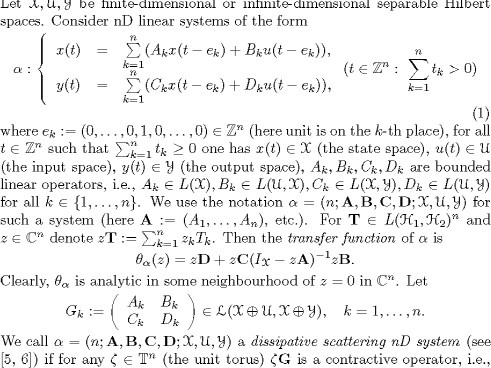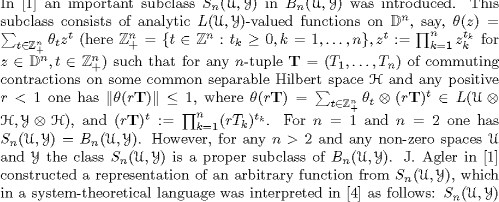Problem 1.3
Does any analytic contractive
operator function on the polydisk
have a dissipative scattering
nD realization?
Dmitry S. Kalyuzhniy-Verbovetzky
Department of Mathematics
The Weizmann Institute of Science
Rehovot 76100
Israel
1 DESCRIPTION OF THE PROBLEM

![]() It is known [5] that the transfer function of a dissipative scattering nD system
It is known [5] that the transfer function of a dissipative scattering nD system ![]() belongs to the subclass
belongs to the subclass ![]() of the class
of the class ![]() of all analytic contractive
of all analytic contractive ![]() -valued functions on the open unit polydisk
-valued functions on the open unit polydisk ![]() , which is segregated by the condition of vanishing of its functions at z = 0. The question whether the converse is true was implicitly asked in [5] and still has not been answered. Thus, we pose
the following problem.
, which is segregated by the condition of vanishing of its functions at z = 0. The question whether the converse is true was implicitly asked in [5] and still has not been answered. Thus, we pose
the following problem.
Problem: Either prove that an arbitrary ![]() can be realized as the transfer function of a dissipative scattering nD system of the form (1) with the input space
can be realized as the transfer function of a dissipative scattering nD system of the form (1) with the input space ![]() and the output space
and the output space ![]() , or give an example of a function
, or give an example of a function ![]() (for some
(for some ![]() , and some finite-dimensional or infinite-dimensional separable Hilbert spaces
, and some finite-dimensional or infinite-dimensional separable Hilbert spaces ![]() that has no such a realization.
that has no such a realization.
2 MOTIVATION AND HISTORY OF THE PROBLEM
For n = 1 the theory of dissipative (or passive, in other terminology) scattering linear systems is well developed (see, e.g.,
[2, 3]) and related to various problems of physics (in particular, scattering theory), stochastic processes, control theory,
operator theory, and 1D complex analysis. It is well known (essentially, due to [8]) that the class of transfer functions
of dissipative scattering 1D systems of the form (1) with the input space ![]() and the output space
and the output space ![]() coincides with
coincides with ![]() . Moreover, this class of transfer functions remains the same when one is restricted within the important special case of
conservative scattering 1D systems, for which the system block matrix G is unitary, i.e.,
. Moreover, this class of transfer functions remains the same when one is restricted within the important special case of
conservative scattering 1D systems, for which the system block matrix G is unitary, i.e., ![]() Let us note that in the case n = 1 a system (1) can be rewritten in an equivalent form (without a unit delay in output signal
y) that is the standard form of a linear system, then a transfer function does not necessarily vanish at z = 0, and the class
of transfer functions turns into the Schur class
Let us note that in the case n = 1 a system (1) can be rewritten in an equivalent form (without a unit delay in output signal
y) that is the standard form of a linear system, then a transfer function does not necessarily vanish at z = 0, and the class
of transfer functions turns into the Schur class ![]() The classes
The classes ![]() and
and ![]() are canonically isomorphic due to the relation
are canonically isomorphic due to the relation ![]() ).
).

coincides with the class of transfer functions of nD systems of Roesser type with the input space ![]() and the output space
and the output space ![]() , and certain conservativity condition imposed. The analogous result is valid for conservative systems of the form (1). A
system
, and certain conservativity condition imposed. The analogous result is valid for conservative systems of the form (1). A
system ![]() is called a conservative scattering nD system if for any
is called a conservative scattering nD system if for any ![]() the operator
the operator ![]() is unitary. Clearly, a conservative scattering system is a special case of a dissipative one. By [5], the class of transfer
functions of conservative scattering nD systems coincides with the subclass
is unitary. Clearly, a conservative scattering system is a special case of a dissipative one. By [5], the class of transfer
functions of conservative scattering nD systems coincides with the subclass ![]() , which is segregated from the latter by the condition of vanishing of its functions at z = 0. Since for n = 1 and n = 2 one
has
, which is segregated from the latter by the condition of vanishing of its functions at z = 0. Since for n = 1 and n = 2 one
has ![]() ), this gives the whole class of transfer functions of dissipative scattering nD systems of the form (1), and the solution
to the problem formulated above for these two cases.
), this gives the whole class of transfer functions of dissipative scattering nD systems of the form (1), and the solution
to the problem formulated above for these two cases.
In [6] the dilation theory for nD systems of the form (1) was developed. It was proven that ![]() has a conservative dilation if and only if the corresponding linear function
has a conservative dilation if and only if the corresponding linear function ![]() belongs to (
belongs to (![]() . Systems that satisfy this criterion are called n-dissipative scattering ones. In the cases n = 1 and n = 2 the subclass of n-dissipative scattering systems coincides with the whole class of dissipative ones, and in the case n > 2 this subclass is proper. Since transfer functions of a system and of its dilation coincide, the class of transfer functions
of n-dissipative scattering systems with the input space
. Systems that satisfy this criterion are called n-dissipative scattering ones. In the cases n = 1 and n = 2 the subclass of n-dissipative scattering systems coincides with the whole class of dissipative ones, and in the case n > 2 this subclass is proper. Since transfer functions of a system and of its dilation coincide, the class of transfer functions
of n-dissipative scattering systems with the input space ![]() and the output space
and the output space ![]() is 0n
is 0n ![]() . According to [7], for any n > 2 there exist
. According to [7], for any n > 2 there exist ![]() , operators
, operators ![]()
![]() and commuting contractions
and commuting contractions ![]() , . . . , n, such that
, . . . , n, such that

The syste![]() is a dissipative scattering one, however not, n-dissipative. Its transfer function
is a dissipative scattering one, however not, n-dissipative. Its transfer function ![]() )
) ![]()
Since for functions in B0n ![]() (U, Y)S0n (U, Y) the realization technique elaborated in [1] and developed in [4] and [5] is not applicable, our problem
is of current interest.
(U, Y)S0n (U, Y) the realization technique elaborated in [1] and developed in [4] and [5] is not applicable, our problem
is of current interest.
BIBLIOGRAPHY
[1] J. Agler, “On the representation of certain holomorphic functions defined on a polydisc, ” Topics in Operator Theory: Ernst D. Hellinger Memorial Volume (L. de Branges, I. Gohberg, and J. Rovnyak, Eds.), Oper. Theory Adv. Appl. 48, pp. 47-66 (1990).
[2] D. Z. Arov, “Passive linear steady-state dynamic systems, ” Sibirsk. Math. Zh. 20 (2), 211-228 (1979), (Russian).
[3] J. A. Ball and N. Cohen, “De Branges-Rovnyak operator models and systems theory: A survey, ” Topics in Matrix and Operator Theory (H.
Bart, I. Gohberg, and M.A. Kaashoek, eds.), Oper. Theory Adv. Appl., 50, pp. 93-136 (1991).
[4] J. A. Ball and T. Trent, “Unitary colligations, reproducing kernel hilbert spaces, and Nevanlinna-Pick interpolation in several variables, ”J. Funct. Anal. 157, pp. 1-61 (1998).
[5] D. S. Kalyuzhniy, “Multiparametric dissipative linear stationary dynamical scattering systems: Discrete case, ” J. Operator Theory, 43 (2), pp. 427-460 (2000).
[6] D. S. Kalyuzhniy, “Multiparametric dissipative linear stationary dynamical scattering systems: Discrete case, II: Existence of conservative dilations, ” Integr. Eq. Oper. Th., 36 (1), pp. 107-120 (2000).
[7] D. S. Kalyuzhniy, “On the von Neumann inequality for linear matrix functions of several variables, ” Mat. Zametki 64 (2), pp. 218-223 (1998), (Russian); translated in Math. Notes 64 (2), pp. 186-189 (1998).
[8] B. Sz.-Nagy and C. Foias, Harmonic Analysis of Operators on Hilbert Spaces, North Holland, Amsterdam, 1970.
